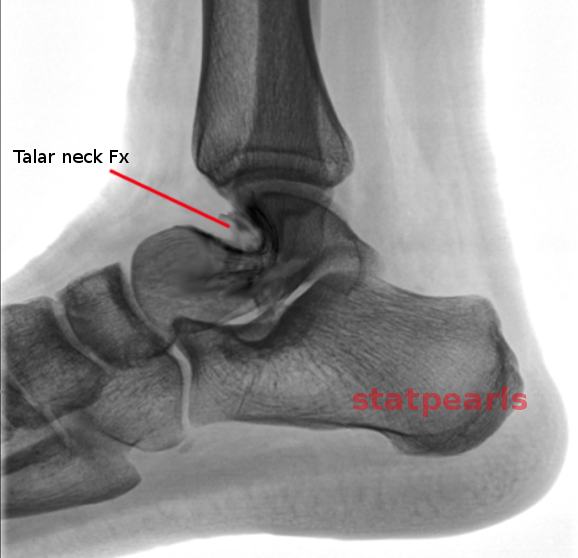[1]
Fortin PT,Balazsy JE, Talus fractures: evaluation and treatment. The Journal of the American Academy of Orthopaedic Surgeons. 2001 Mar-Apr;
[PubMed PMID: 11281635]
[2]
Jordan RK,Bafna KR,Liu J,Ebraheim NA, Complications of Talar Neck Fractures by Hawkins Classification: A Systematic Review. The Journal of foot and ankle surgery : official publication of the American College of Foot and Ankle Surgeons. 2017 Jul - Aug;
[PubMed PMID: 28633784]
Level 1 (high-level) evidence
[4]
Whitaker C,Turvey B,Illical EM, Current Concepts in Talar Neck Fracture Management. Current reviews in musculoskeletal medicine. 2018 Sep;
[PubMed PMID: 29974334]
[5]
Hawkins LG, Fractures of the neck of the talus. The Journal of bone and joint surgery. American volume. 1970 Jul;
[PubMed PMID: 5479485]
[6]
Sanders DW,Busam M,Hattwick E,Edwards JR,McAndrew MP,Johnson KD, Functional outcomes following displaced talar neck fractures. Journal of orthopaedic trauma. 2004 May-Jun;
[PubMed PMID: 15105747]
[7]
Ebraheim NA,Sabry FF,Nadim Y, Internal architecture of the talus: implication for talar fracture. Foot
[PubMed PMID: 10609708]
[8]
Thomas JL,Boyce BM, Radiographic analysis of the Canale view for displaced talar neck fractures. The Journal of foot and ankle surgery : official publication of the American College of Foot and Ankle Surgeons. 2012 Mar-Apr;
[PubMed PMID: 22154058]
[9]
Williams T,Barba N,Noailles T,Steiger V,Pineau V,Carvalhana G,Le Jacques B,Clave A,Huten D, Total talar fracture - inter- and intra-observer reproducibility of two classification systems (Hawkins and AO) for central talar fractures. Orthopaedics
[PubMed PMID: 22613935]
[10]
Canale ST,Kelly FB Jr, Fractures of the neck of the talus. Long-term evaluation of seventy-one cases. The Journal of bone and joint surgery. American volume. 1978 Mar;
[PubMed PMID: 417084]
Level 3 (low-level) evidence
[11]
Day MA,Compton JT,Buckwalter JA 5th, Leland G. Hawkins, MD-His Life and Orthopaedic Legacy: Talus Fractures and the Hawkins Classification. The Iowa orthopaedic journal. 2018;
[PubMed PMID: 30104918]
[12]
Sangeorzan BJ,Wagner UA,Harrington RM,Tencer AF, Contact characteristics of the subtalar joint: the effect of talar neck misalignment. Journal of orthopaedic research : official publication of the Orthopaedic Research Society. 1992 Jul;
[PubMed PMID: 1613628]
[13]
Dodd A,Lefaivre KA, Outcomes of Talar Neck Fractures: A Systematic Review and Meta-analysis. Journal of orthopaedic trauma. 2015 May;
[PubMed PMID: 25635362]
Level 1 (high-level) evidence
[14]
Santavirta S,Seitsalo S,Kiviluoto O,Myllynen P, Fractures of the talus. The Journal of trauma. 1984 Nov;
[PubMed PMID: 6502773]
[15]
Lindvall E,Haidukewych G,DiPasquale T,Herscovici D Jr,Sanders R, Open reduction and stable fixation of isolated, displaced talar neck and body fractures. The Journal of bone and joint surgery. American volume. 2004 Oct;
[PubMed PMID: 15466732]
[16]
Elgafy H,Ebraheim NA,Tile M,Stephen D,Kase J, Fractures of the talus: experience of two level 1 trauma centers. Foot
[PubMed PMID: 11139032]
[17]
Fleuriau Chateau PB,Brokaw DS,Jelen BA,Scheid DK,Weber TG, Plate fixation of talar neck fractures: preliminary review of a new technique in twenty-three patients. Journal of orthopaedic trauma. 2002 Apr;
[PubMed PMID: 11927801]
[18]
Huang PJ,Cheng YM, Delayed surgical treatment for neglected or mal-reduced talar fractures. International orthopaedics. 2005 Oct;
[PubMed PMID: 16094539]
[19]
Halvorson JJ,Winter SB,Teasdall RD,Scott AT, Talar neck fractures: a systematic review of the literature. The Journal of foot and ankle surgery : official publication of the American College of Foot and Ankle Surgeons. 2013 Jan-Feb;
[PubMed PMID: 23153783]
Level 1 (high-level) evidence
[20]
Metzger MJ,Levin JS,Clancy JT, Talar neck fractures and rates of avascular necrosis. The Journal of foot and ankle surgery : official publication of the American College of Foot and Ankle Surgeons. 1999 Mar-Apr;
[PubMed PMID: 10334706]
[21]
Pajenda G,Vécsei V,Reddy B,Heinz T, Treatment of talar neck fractures: clinical results of 50 patients. The Journal of foot and ankle surgery : official publication of the American College of Foot and Ankle Surgeons. 2000 Nov-Dec;
[PubMed PMID: 11131473]
[22]
Szyszkowitz R,Reschauer R,Seggl W, Eighty-five talus fractures treated by ORIF with five to eight years of follow-up study of 69 patients. Clinical orthopaedics and related research. 1985 Oct;
[PubMed PMID: 4042502]
[23]
Penny JN,Davis LA, Fractures and fracture-dislocations of the neck of the talus. The Journal of trauma. 1980 Dec;
[PubMed PMID: 7452746]
[24]
Lorentzen JE,Christensen SB,Krogsoe O,Sneppen O, Fractures of the neck of the talus. Acta orthopaedica Scandinavica. 1977 May;
[PubMed PMID: 868480]
[26]
Buza JA 3rd,Leucht P, Fractures of the talus: Current concepts and new developments. Foot and ankle surgery : official journal of the European Society of Foot and Ankle Surgeons. 2018 Aug;
[PubMed PMID: 29409210]
[27]
Shibuya N,Davis ML,Jupiter DC, Epidemiology of foot and ankle fractures in the United States: an analysis of the National Trauma Data Bank (2007 to 2011). The Journal of foot and ankle surgery : official publication of the American College of Foot and Ankle Surgeons. 2014 Sep-Oct;
[PubMed PMID: 24785202]
[28]
Amin S,Achenbach SJ,Atkinson EJ,Khosla S,Melton LJ 3rd, Trends in fracture incidence: a population-based study over 20 years. Journal of bone and mineral research : the official journal of the American Society for Bone and Mineral Research. 2014 Mar;
[PubMed PMID: 23959594]
[29]
Miller AN,Prasarn ML,Dyke JP,Helfet DL,Lorich DG, Quantitative assessment of the vascularity of the talus with gadolinium-enhanced magnetic resonance imaging. The Journal of bone and joint surgery. American volume. 2011 Jun 15;
[PubMed PMID: 21776548]
[30]
Oppermann J,Franzen J,Spies C,Faymonville C,Knifka J,Stein G,Bredow J, The microvascular anatomy of the talus: a plastination study on the influence of total ankle replacement. Surgical and radiologic anatomy : SRA. 2014 Jul;
[PubMed PMID: 24162267]
[31]
Xue Y,Zhang H,Pei F,Tu C,Song Y,Fang Y,Liu L, Treatment of displaced talar neck fractures using delayed procedures of plate fixation through dual approaches. International orthopaedics. 2014 Jan;
[PubMed PMID: 24297608]
[32]
Attiah M,Sanders DW,Valdivia G,Cooper I,Ferreira L,MacLeod MD,Johnson JA, Comminuted talar neck fractures: a mechanical comparison of fixation techniques. Journal of orthopaedic trauma. 2007 Jan;
[PubMed PMID: 17211269]

